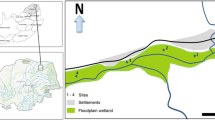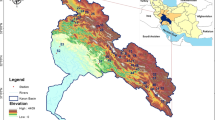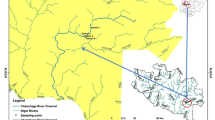Abstract
Indicator species (IS) have been employed in modern aquatic research for monitoring of environmental changes and evaluating the efficiency of environmental management procedures. In this study, we evaluated the possibility of developing surrogate indicator groups as tools for the conservation and management of the biodiversity of Northern Nigeria streams by surveying 15 streams in Niger state for benthic macroinvertebrates and environmental variables as data sets, over a period of 24 months (2016 and 2017). Samples were collected in two locations of reference and impacted sites for each of the streams surveyed. The statistically significant (P < 0.05; based on 1000 permutations) indicator species for each of the status classes (reference versus impacted) was identified using the indicator species analysis/indicator value (Indval) method. Canonical correspondence analysis (CCA) was used to evaluate the IS-environment relationships. Indicator value found fifteen species for the reference streams including Ephemeropteran (Bugilliesia sp., Tricorythus sp., Thraulus sp., Crassabwa sp.) and the Tricopteran (Leptonema sp.). Opposite, the Indval found seven (7) indicator species for the impacted streams, which included the Dipteran (Pentaneura sp., Tabanus sp.). Multivariate analysis revealed that species assemblage had wide dispersal patterns in relation to the sites for both status classes. CCA revealed that the reference and impacted indicator species responded to entirely different environmental factors, indicating their preference to particular environmental variables along the ecological gradients. While the indicator species of reference sites were associated with environmental predictors of good water quality such as high DO, increased flow, low conductivity, and low BOD, the indicator species of impacted sites were strongly related to environmental predictors of anthropogenic pollution, including low DO, high BOD, and increased nutrients concentrations. This study has provided a reference point and effective tool to monitor environmental changes, community, and ecosystem dynamics across the Northern Nigeria streams.




Similar content being viewed by others
Data Availability
The raw data supporting the conclusions of this article will be made available by the authors, without undue reservation.
References
Andem AB, Okorafor KA, Eyo VO, Ekpo PB (2014) Ecological impact assessment and limnological characterization in the intertidal region of Calabar River using benthic macroinvertebrates as bioindicator organisms. Int J Fish Aquat Stud 1(2):8–14
Angermeier PL, Winston MR (1997) Assessing conservation value of stream communities: a comparison of approaches based on centers of density and species richness. Freshw Biol 37:699–710
APHA (American Public Health Association). (1998). Standard methods for the examination of water and wastewater. New York: APHA.
Arimoro FO, Keke NU (2017) The intensity of human-induced impacts on the distribution and diversity of macroinvertebrates and water quality of Gbako River, North Central, Nigeria. Energy, Ecology, and Environment 2:143–154. https://doi.org/10.1007/s40974-016-0025-8
Arimoro FO, Auta YI, Odume ON, Keke NU, Mohammed AZ (2018a) Mouthpart deformities in Chironomidae (Diptera) as bioindicators of heavy metals pollution in Shiroro Lake, Niger State, Nigeria. Ecotoxicol Environ Saf 149:96–100
Arimoro FO, James HM (2008) Preliminary pictorial guide to the macroinvertebrates of Delta State Rivers, Southern Nigeria. Albany Museum, Grahamstown
Arimoro FO, Olisa HE, Keke UN, Ayanwale AV, Chukwuemeka VI (2018b) Exploring spatio-temporal patterns of plankton diversity and community structure as correlates of water quality in tropical stream. Acta Ecol Sin 38:216–223. https://doi.org/10.1016/j.chnaes.2017.10.002
Arimoro FO, Obi-Iyeke GE, Obukeni PJO (2012) Spatiotemporal variation of macroinvertebrates in relation to canopy cover and other environmental factors in Eriora River, Niger Delta, Nigeria. Environ Monit Assess 184:6449–6461
Bartell SM (2006) Biomarkers, bioindicators, and ecological risk assessment—a brief review and evaluation. Environ Bioindic 1:39–52
Borrett SR, Moody J, Edelmann A (2014) The rise of network ecology: maps of the topic diversity and scientific collaboration. Ecol Model 10:111–127
Brittain JE, Heino J, Friberg N, Aroviita J, Kahlert M, Karjalainen S, Keck F, Lento J, Liljaniemi P, Mykrä H, Schneider SC, Ylikörkkö J (2020) Ecological correlates of riverine diatom and macroinvertebrate alpha and beta diversity across Arctic Fennoscandia Freshwater Biology https://doi.org/10.1111/fwb.13616
Brown BL, Swan CM, Auerbach DA, Campbell-Grant EH, Hitt NP, Maloney KO, Patrick C (2011) Metacommunity theory as a multispecies, multiscale framework for studying the influence of river network structure on riverine communities and ecosystems. J N Am Benthol Soc 30:310–327
Brunbjerg AK, Borchenius F, Eiserhardt WL, Ejrnæs R, Svenning JC (2012) Disturbance drives phylogenetic community structure in coastal dune vegetation. J Veg Sci 23:082–1094
Burger J (2006) Bioindicators: types, development, and use in ecological assessment and research. Environ Bioindic 1:22–39
Cai Y, Zhang Y, Wu Z, Chen Y, Xu J, Gong Z (2017) Composition, diversity, and environmental correlates of benthic macroinvertebrate communities in the five largest freshwater lakes of China. Hydrobiologia 788(1):85–98. https://doi.org/10.1007/s10750-016-2989-y
Caro T (2010) Conservation by proxy: indicator, umbrella, keystone, flagship, and other surrogate species. Island Press, Washington, DC
Clarke KR, Warwick RM (1994) Change in marine communities: an approach to statistical analysis and interpretation. Plymouth marine laboratory, UK
Day JA, Harrison AD, de Moor IJ (2002) Guides to the freshwater invertebrates of Southern Africa, vol 9. Water Research Commission, Pretoria, pp 25–90
de Moor IJ, Day JA & de Moor FC (2003) Guides to the freshwater invertebrates of Southern Africa, vol. 7. Insecta I (Ephemeroptera, Odonata and Plecoptera) TT. Pretoria: Water Research Commission, pp. 25-151.
Dobson M, Magana A, Mathooko JM, Ndegwa FK (2002) Detritivores in Kenya highland streams: more evidence for the paucity of shredders in the tropics? Freshw Biol 47:909–919
Dufrêne M, Legendre P (1997) Species assemblages and indicator species: the need for flexible asymmetrical approach. Ecol Monogr 67:345–366
Gordon ND, Mc Mahon TA, Finlayson BL (1994) Stream hydrology, an introduction for ecologists. John Wiley and Sons, New York, pp 543–611
Heino J, Mykrä H (2008) Control of stream insects assemblages: roles of spatial configuration and local environmental variables. Ecol Entomol 33:614–622
Heino J (2010) Are indicator groups and cross-taxon congruence useful for predicting biodiversity in aquatic ecosystems? Ecol Indic 10:112–117
Heino J, Ilmonen J, Paasivirta L (2014) Continuous variation of macroinvertebrate communities along environmental gradients in northern streams. Boreal Environ Res 19:21–38
Helmus MR, Keller WB, Paterson MJ, Yan ND, Cannon CH, Rusak JA (2010) Communities contain closely related species during ecosystem disturbance. Ecol Lett 13:162–174
Jeffries M, Mills D (1990) Freshwater ecology principles and applications. Belhaven Press, London, pp 84–92
Keke UN, Arimoro FO, Auta YI, Ayanwale AV (2017) Temporal and spatial variability in macroinvertebrate community structure in relation to environmental variables in Gbako River, Niger State, Nigeria. Trop Ecol 58(2):229–240
Keke UN, Mgbemena AS, Arimoro FO, Omalu ICJ (2020a) Biomonitoring of effects and accumulations of heavy metals insults using some helminth parasites of fish as bio-indicators in an Afrotropical stream. Front Environ Sci 8:576080. https://doi.org/10.3389/fenvs.2020.576080
Keke UN, Arimoro FO, Ayanwale AV, Odume ON, Edegbene AO (2020b) Biodiversity patterns along seasonality and environmental factors of stream macroinvertebrate communities of North-Central Nigeria. Egyptian J Aquat Biol Fish 24(4):521–534
Legendre P, Legendre L (1998) Numerical ecology, 2nd edn. Elsevier, Amsterdam
Leibold MA, Holyoak M, Mouquet N, Amarasekare P, Chase JM, Hoopes MF, Holt RD, Shurin JB, Law R, Tilman D, Loreau M, Gonzalez A (2004) The metacommunity concept: a framework for multi-scale community ecology. Ecol Lett 7(7):601–613
Luiselli L (2009) A model assessing the conservation threats to freshwater turtles of sub-Saharan Africa predicts urgent need for continental conservation planning. Biodivers Conserv 18(5):1349–1360
Maagad L (2012) Benthic macroinvertebrates and water quality of Iligan River, Unpublished master’s thesis. Mindanao State University-Iligan Institute of Technology, Iligan City, Philippines
McCune, B. & Mefford, M. J. (1999). Multivariate analysis of ecological data (version 4.25); MjM Software. USA. Gleneden Beach.
McCune B, Grace JB (2002) Analysis of ecological communities; MjM Software Design. Gleneden Beach, USA
McGeoch MA, Chown SL (1998) Scaling up the value of bioindicators. Trends Ecol Evol 13:46–47
Merovich GT Jr, Petty JT (2010) Continuous response of benthic macroinvertebrate assemblages to a discrete disturbance gradient: consequences for diagnosing stressors. J N Am Benthol Soc 29:1241–1257
Merritt, R. W. & Cummins, K. W. (1996). An introduction to the aquatic insects of North America (3rded.). Dubuque: Kendall-Hunt, pp. 134-142.
Mustonen K, Mykrä H, Louhi P, Markkola A, Tolkkinen M, Huusko A, Alioravainen N, Lehtinen S, Muotka T (2016) Sediments and flow have mainly independent effects on multitrophic stream communities and ecosystem functions. Ecol Indic 26(7):2116–2129
Mykrä H, Tolkkinen M, Markkola AM, Pirttilä AM, Muotka T (2016) Phylogenetic clustering of fungal communities in human-disturbed streams. Ecosphere 7(3):1–12 :e01316. https://doi.org/10.1002/ecs2.1316
Odume ON, Muller WJ, Arimoro FO, Palmer CG (2012) The impact of water quality deterioration on macroinvretebrate communities in Swartkops River, South Africa: a multimetric approach. Afr J Aquat Sci 37(2):191–200
Paavola R, Muotka T, Virtanen R, Heino J, Kreivi P (2003) Are biological classifications of headwater streams concordant across multiple taxonomic groups? Freshw Biol 48:1912–1923
Petersen WT, Keister JE (2003) Interannual variability in copepod community composition at a coastal station in the northern California Current: a multivariate approach. Deep-Sea Res 50:2499–2517
R Core Team. (2017). R: a language and environment for statistical computing. R foundation for statistical computing. R Core Team, Vienna, Austria. Version 2.15.3. Available at: http://www.R-project.org.
Roberts DW (2016) labdsv: Ordination and multivariate analysis for ecology. R package version 1.8-0. Retrieved from https://CRAN.R-project.org/packa ge=labdsv
Rosenberg DM, Resh VH (1993) Freshwater biomonitoring and benthic macroinvertebrates. Chapman and Hall, New York, USA
Sharma KK, Chowdhary S (2011) Macroinvertebrate assemblages as biological indicators of pollution in a Central Himalayan River, Tawi (JK). Int J Biodivers Conserv 3(5):167–174
Sharpe, W. E., Kimmel, W.G. & Buda, A. R. (2015). “Biotic Index Card.” Center For Watershed Stewardship (n.d.): n. pag. Ecosystems.psu.edu. Center For Watershed Stewardship. Accessed 11 June 2015. URL<http://ecosystems.psu.edu/youth/sftrc/lesson-plan-pdfs/BioticIndexCard.pdf.
Siddiga, A. H., Ellison, A. M., Ochsc, A., Villar-Leemand, C. & Laub, M. K. (2016). How do ecologists select and use indicator species to monitor ecological change? Insights from 14 years of publication in Ecological Indicators. Ecological Indicators, 60, 223–230.
Simaika JP, Samways MJ (2011) Comparative assessments of indices of freshwater habitat conditions using different invertebrate taxon sets. Ecol Indic 11:30–378
Spellerberg IF (2005) Monitoring ecological change. Cambridge University Press, Cambridge
Su P, Wang X, Lin Q, Peng J, Song J, Fu J, Wang S, Cheng D, Bai H, Li Q (2019) Variability in macroinvertebrate community structure and its response to ecological factors of the Weihe River Basin. China Ecological Engineering 140:105595. https://doi.org/10.1016/j.ecoleng.2019.105595
Swan CM, Brown BL (2011) Advancing theory of community assembly in spatially structured environments: local vs regional processes in river networks. J N Am Benthol Soc 30(1):232–234
ter Braak CJF, Verdonschot PFM (1995) Canonical correspondence analysis and related multivariate methods in aquatic ecology. Aquat Sci 57(3):256–289
Ter Braak CJF (1995) Ordination. In: Jongman RHG, ter Braak CJF, van Tongeren OFR (eds) Data analysis in community and landscape ecology. Cambridge University Press, Cambridge
Tonkin JD, Arimoro FO, Haase P (2016) Exploring stream communities in a tropical biodiversity hotspot: biodiversity, regional occupancy, niche characteristics, and environmental correlates. Biodivers Conserv 25:975–993
Tripathi M, Singal SK (2019) Use of principal component analysis for parameter selection for development of a novel water quality index: a case study of river Ganga India. Ecol Indic 96:430–436
Ward JV (1992) Aquatic insects ecology. John Wiley, New York, pp 87–99
Funding
This work was supported by the International Foundation for Science, Sweden in a grant given to the second author (IFS ref: I-2-A-6209-1). This experiment complied with the current laws of the country, Nigeria, in which it was performed.
Author information
Authors and Affiliations
Contributions
FOA and UNK wrote the manuscript while UNK performed data analysis. FOA designed the study. UNK designed the study and performed the sample collection and analysis. All authors read and approved the final manuscript.
Corresponding author
Ethics declarations
Ethical approval
Not applicable.
Consent to participate
Not applicable.
Consent to publish
Not applicable.
Competing interests
The authors declare no competing interests.
Additional information
Responsible Editor: Thomas Hein
Publisher’s note
Springer Nature remains neutral with regard to jurisdictional claims in published maps and institutional affiliations.
Supplementary Information
ESM 1
(DOCX 14 kb)
Rights and permissions
About this article
Cite this article
Arimoro, F.O., Keke, U.N. Stream biodiversity and monitoring in North Central, Nigeria: the use of macroinvertebrate indicator species as surrogates. Environ Sci Pollut Res 28, 31003–31012 (2021). https://doi.org/10.1007/s11356-021-12922-w
Received:
Accepted:
Published:
Issue Date:
DOI: https://doi.org/10.1007/s11356-021-12922-w




